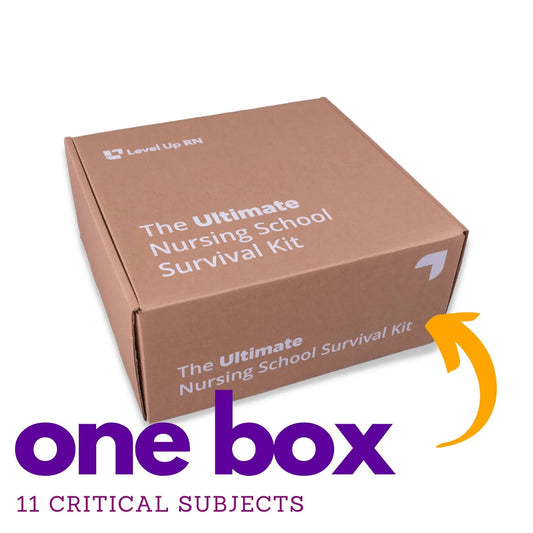Nursing Tips
Nutrition (35)

Hyperkalemia & Hypokalemia
The MOST important side effect to know for BOTH hyperkalemia and hypokalemia is DYSRHYTHMIAS.
Hyperkalemia & Hypokalemia
The MOST important side effect to know for BOTH hyperkalemia and hypokalemia is DYSRHYTHMIAS.
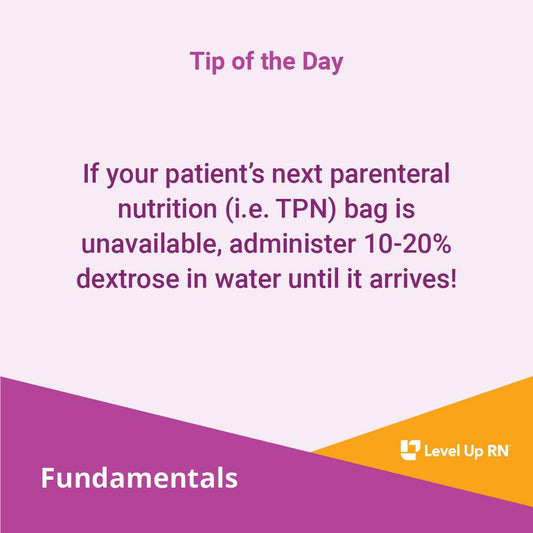
Unavailable Parenteral Nutrition
If your patient's next parenteral nutrition (i.e. TPN) line is unavailable, administer 10-20% dextrose in water until it arrives!
Unavailable Parenteral Nutrition
If your patient's next parenteral nutrition (i.e. TPN) line is unavailable, administer 10-20% dextrose in water until it arrives!
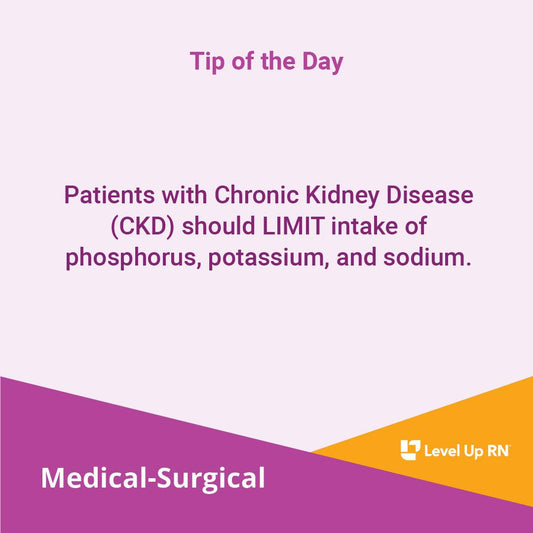
Chronic Kidney Disease
Patients with Chronic Kidney Disease (CKD) should LIMIT intake of phosphorus, potassium, and sodium.
Chronic Kidney Disease
Patients with Chronic Kidney Disease (CKD) should LIMIT intake of phosphorus, potassium, and sodium.

Somogyi Phenomenon
Somogyi phenomenon is morning hyperglycemia due to untreated overnight hypoglycemia. To prevent Somogyi's phenomenon, provide a bedtime snack and insulin.
Somogyi Phenomenon
Somogyi phenomenon is morning hyperglycemia due to untreated overnight hypoglycemia. To prevent Somogyi's phenomenon, provide a bedtime snack and insulin.
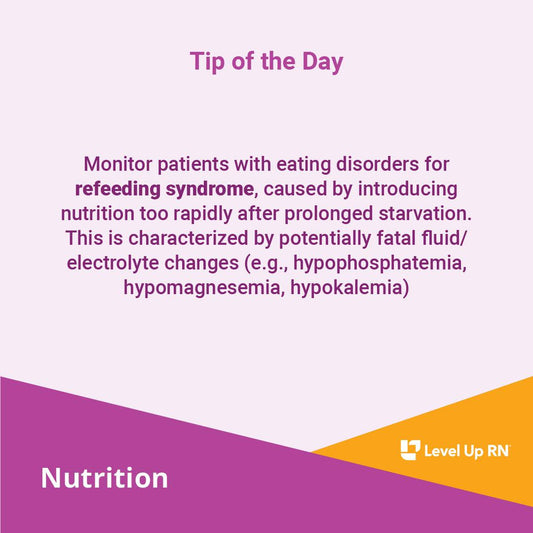
Refeeding Syndrome
Monitor patients with eating disorders for refeeding syndrome, caused by introducing nutrition too rapidly after prolonged starvation.
Refeeding Syndrome
Monitor patients with eating disorders for refeeding syndrome, caused by introducing nutrition too rapidly after prolonged starvation.
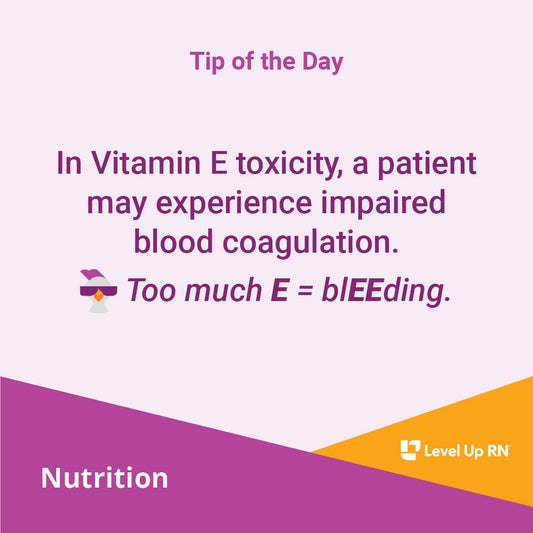
Vitamin E Toxicity
In Vitamin E toxicity, a patient may experience impaired blood coagulation.
Vitamin E Toxicity
In Vitamin E toxicity, a patient may experience impaired blood coagulation.
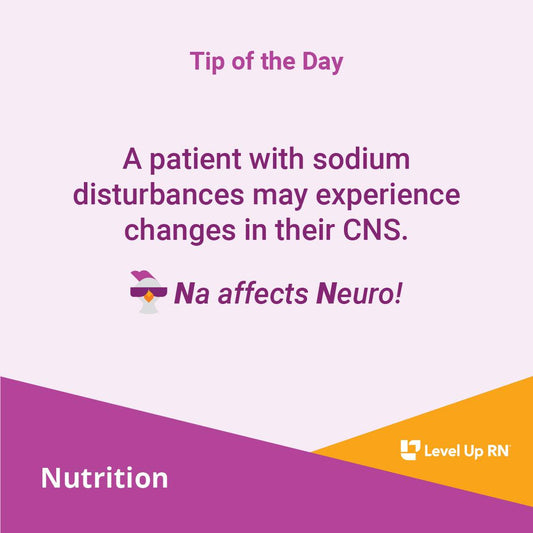
Sodium Disturbances
A patient with sodium disturbances may experience changes in their CNS.
Sodium Disturbances
A patient with sodium disturbances may experience changes in their CNS.
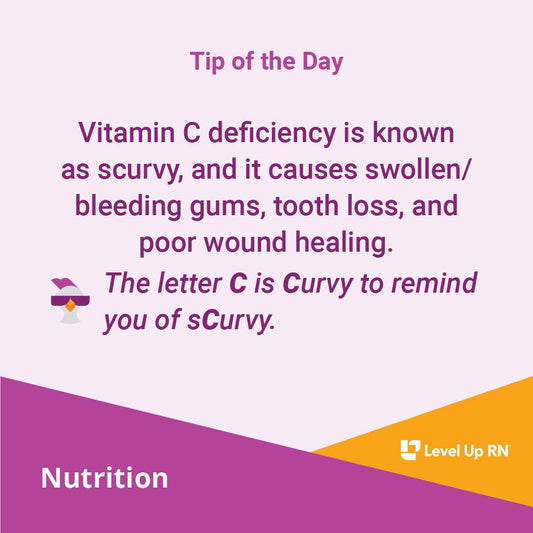
Scurvy
Vitamin C deficiency is known as scurvy, and it causes swollen/bleeding gums, tooth loss, and poor wound healing.
Scurvy
Vitamin C deficiency is known as scurvy, and it causes swollen/bleeding gums, tooth loss, and poor wound healing.

Vitamin B9 (Folic Acid)
Vitamin B9 (folic acid) is needed to prevent neural tube defects in a developing fetus.
Vitamin B9 (Folic Acid)
Vitamin B9 (folic acid) is needed to prevent neural tube defects in a developing fetus.
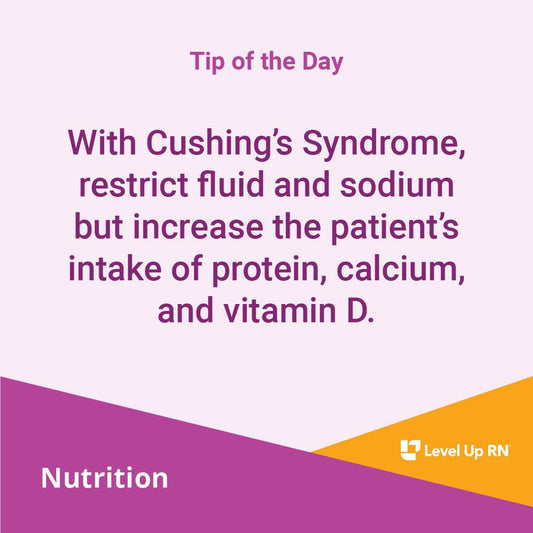
Cushing's Syndrome: Nursing Care
With Cushing's Syndrome, restrict fluid and sodium but increase the patient's intake of protein, calcium, and vitamin D.
Cushing's Syndrome: Nursing Care
With Cushing's Syndrome, restrict fluid and sodium but increase the patient's intake of protein, calcium, and vitamin D.

Macronutrients
Carbohydrates and protein each provide 4 kcal of energy/gram. Lipids provide 9 kcal of energy/gram.
Macronutrients
Carbohydrates and protein each provide 4 kcal of energy/gram. Lipids provide 9 kcal of energy/gram.

Dietary Considerations
Ask your patient about any dietary considerations they may have in relation to their religion rather than assuming!
Dietary Considerations
Ask your patient about any dietary considerations they may have in relation to their religion rather than assuming!

Nursing Nutritional Assessment
A nursing nutritional assessment includes a patient's height/weight/BMI, assessing for recent weight loss/gain assessing for difficulty swallowing or chewing, and identifying food allergies, diet restrictions, and religious/cultural dietary preferences.
Nursing Nutritional Assessment
A nursing nutritional assessment includes a patient's height/weight/BMI, assessing for recent weight loss/gain assessing for difficulty swallowing or chewing, and identifying food allergies, diet restrictions, and religious/cultural dietary preferences.
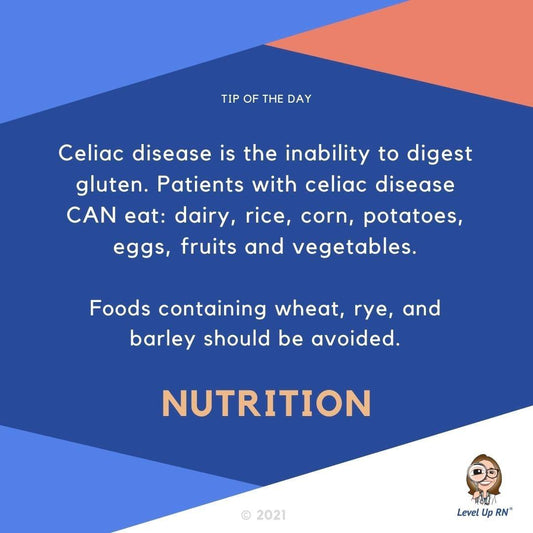
Celiac Disease
Celiac disease is the inability to digest gluten. Patients with celiac disease CAN eat: dairy, rice, corn, potatoes, eggs, fruits and vegetables. Foods containing wheat, rye, and barley should be...
Celiac Disease
Celiac disease is the inability to digest gluten. Patients with celiac disease CAN eat: dairy, rice, corn, potatoes, eggs, fruits and vegetables. Foods containing wheat, rye, and barley should be...

Negative Nitrogen Balance
A negative nitrogen balance indicates insufficient PROTEIN intake (due to illness, malnutrition, or aging). It means the patient is using protein faster than it is being synthesized.
Negative Nitrogen Balance
A negative nitrogen balance indicates insufficient PROTEIN intake (due to illness, malnutrition, or aging). It means the patient is using protein faster than it is being synthesized.
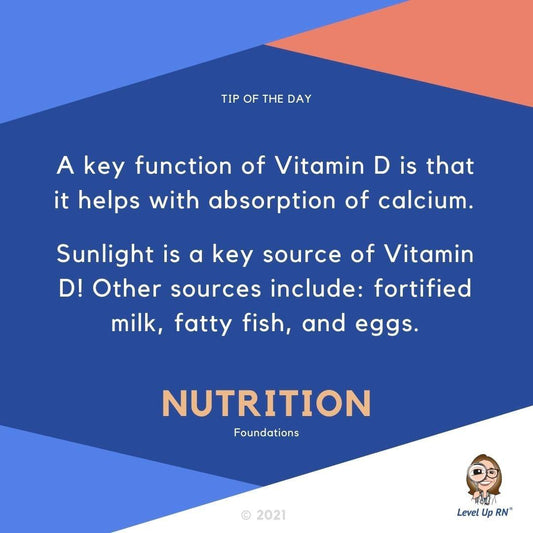
Vitamin D
A key function of Vitamin D is that it helps with absorption of calcium. Sunlight is a key source of Vitamin D! Other sources include: fortified milk, fatty fish, and eggs.
Vitamin D
A key function of Vitamin D is that it helps with absorption of calcium. Sunlight is a key source of Vitamin D! Other sources include: fortified milk, fatty fish, and eggs.
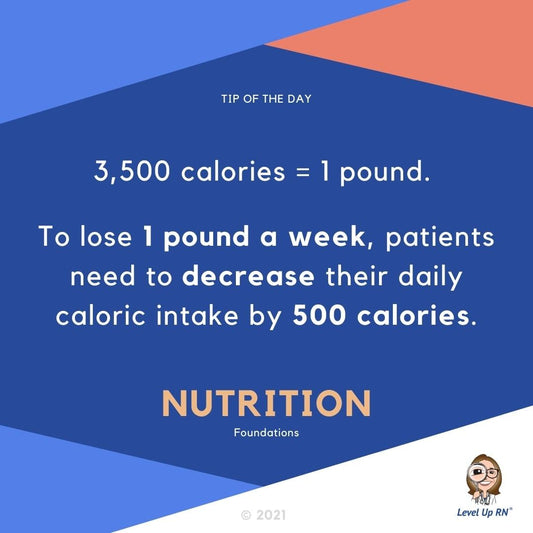
How Many Calories in a Pound?
3,500 calories = 1 pound. To lose 1 pound a week, patients need to decrease their daily caloric intake by 500 calories.
How Many Calories in a Pound?
3,500 calories = 1 pound. To lose 1 pound a week, patients need to decrease their daily caloric intake by 500 calories.
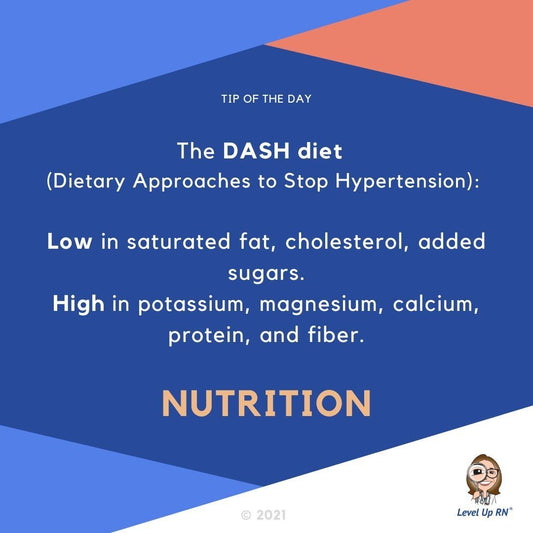
DASH diet & hypertension
The DASH diet (for patients with hypertension) emphasizes low sodium, high potassium, and high calcium foods.
DASH diet & hypertension
The DASH diet (for patients with hypertension) emphasizes low sodium, high potassium, and high calcium foods.

Medications in Nutrition IV Line
Do NOT administer any medications through a patient's parenteral nutrition (i.e. TPN) IV line! You need to use a separate line.
Medications in Nutrition IV Line
Do NOT administer any medications through a patient's parenteral nutrition (i.e. TPN) IV line! You need to use a separate line.
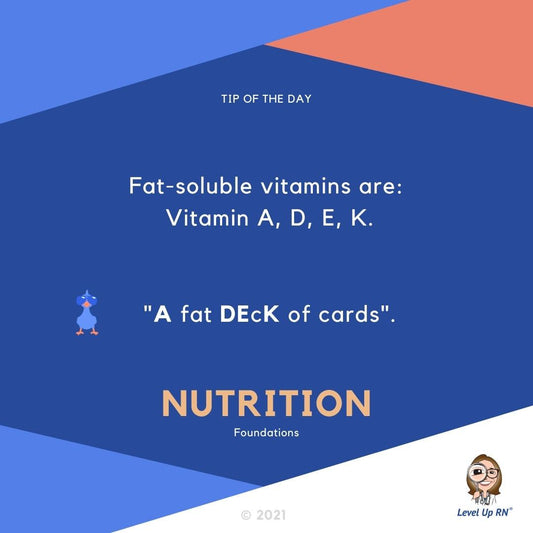
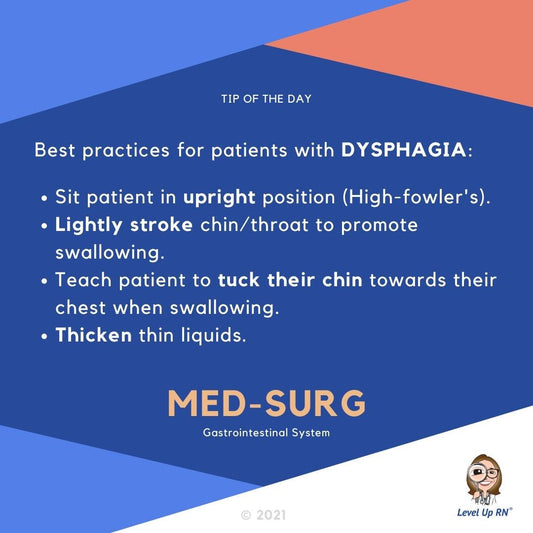
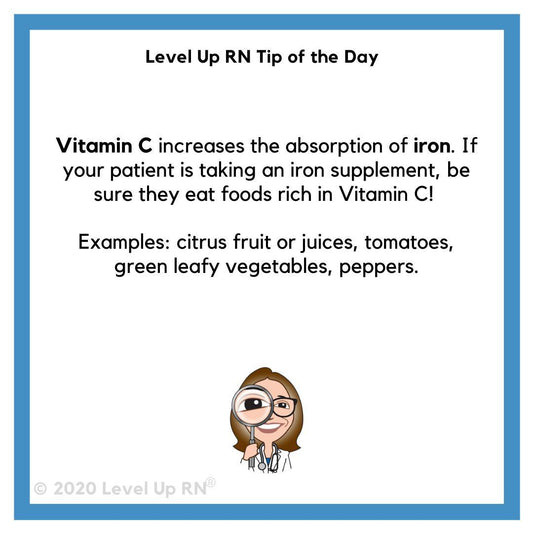
Vitamin C and Iron
Vitamin C increases the absorption of iron. If your patient is taking an iron supplement, be sure they eat foods rich in Vitamin C! Examples: citrus fruit or juices, tomatoes,...
Vitamin C and Iron
Vitamin C increases the absorption of iron. If your patient is taking an iron supplement, be sure they eat foods rich in Vitamin C! Examples: citrus fruit or juices, tomatoes,...
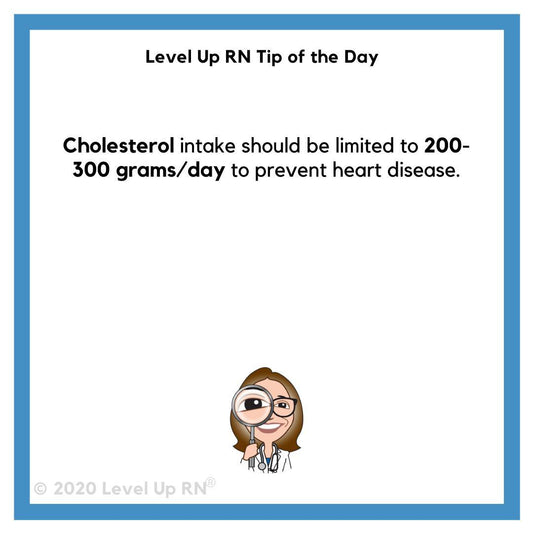
Cholesterol Intake
Cholesterol intake should be limited to 200-300 grams/day to prevent heart disease.
Cholesterol Intake
Cholesterol intake should be limited to 200-300 grams/day to prevent heart disease.
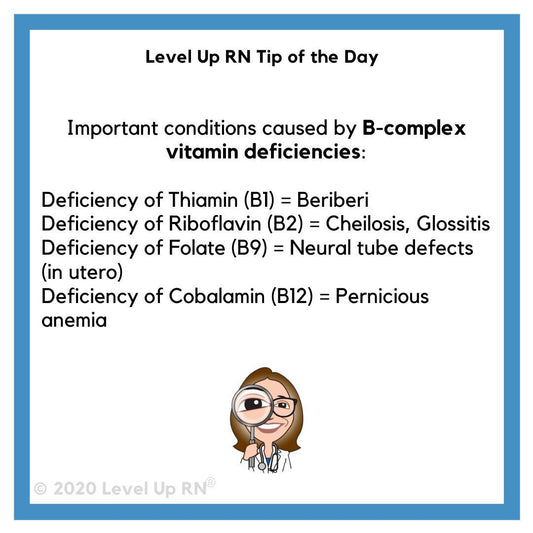
B-Complex Vitamin Deficiencies
Important conditions caused by B-complex vitamin deficiencies: Deficiency of Thiamin (B1) = Beriberi Deficiency of Riboflavin (B2) = Cheilosis, Glossitis Deficiency of Folate (B9) = Neural tube defects (in utero)...
B-Complex Vitamin Deficiencies
Important conditions caused by B-complex vitamin deficiencies: Deficiency of Thiamin (B1) = Beriberi Deficiency of Riboflavin (B2) = Cheilosis, Glossitis Deficiency of Folate (B9) = Neural tube defects (in utero)...
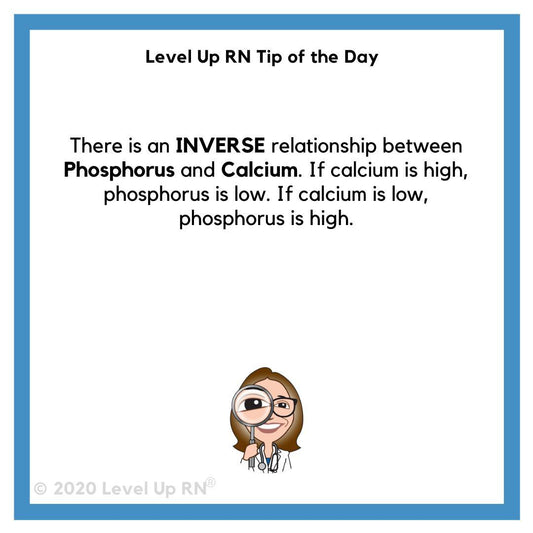
Phosphorus and Calcium Nutrition
There is an INVERSE relationship between Phosphorus and Calcium. If calcium is high, phosphorus is low. If calcium is low, phosphorus is high.
Phosphorus and Calcium Nutrition
There is an INVERSE relationship between Phosphorus and Calcium. If calcium is high, phosphorus is low. If calcium is low, phosphorus is high.

Dumping Syndrome Nutrition
Nutrition recommendations to prevent DUMPING syndrome: Consume small frequent meals. Do not drink liquids with meals. Include protein and fat at each meal. Avoid dairy products and concentrated sugar.
Dumping Syndrome Nutrition
Nutrition recommendations to prevent DUMPING syndrome: Consume small frequent meals. Do not drink liquids with meals. Include protein and fat at each meal. Avoid dairy products and concentrated sugar.
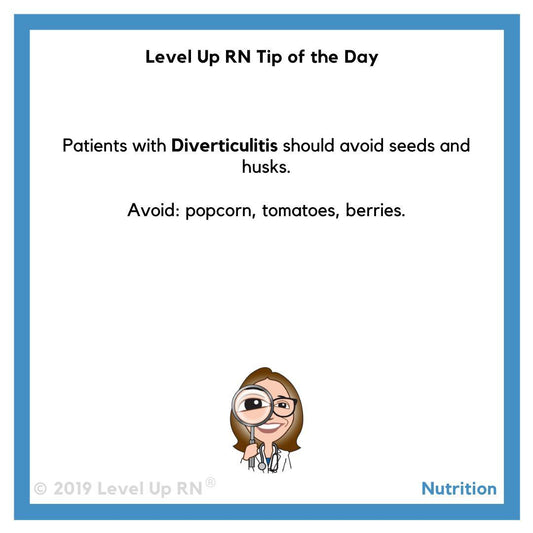
Diverticulitis Nutrition
Patients with Diverticulitis should avoid seeds and husks. Avoid: popcorn, tomatoes, berries.
Diverticulitis Nutrition
Patients with Diverticulitis should avoid seeds and husks. Avoid: popcorn, tomatoes, berries.
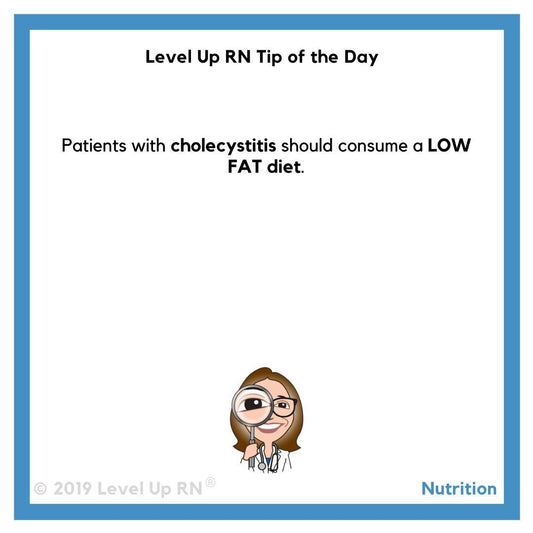
Cholecystitis Nutrition
Patients with cholecystitis should consume a LOW FAT diet.
Cholecystitis Nutrition
Patients with cholecystitis should consume a LOW FAT diet.
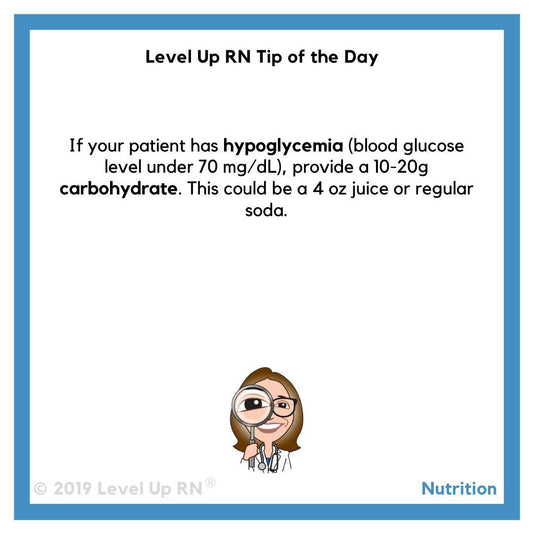
Hypoglycemia
If your patient has hypoglycemia (blood glucose level under 70 mg/dL), provide a 10-20g carbohydrate. This could be a 4 oz juice or regular soda.
Hypoglycemia
If your patient has hypoglycemia (blood glucose level under 70 mg/dL), provide a 10-20g carbohydrate. This could be a 4 oz juice or regular soda.
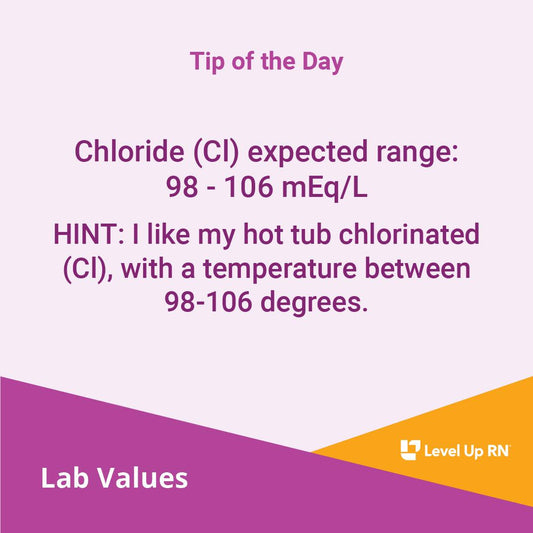
Chloride: Expected Range
Chloride (Cl) expected range: 98 - 106 mEq/L HINT: I like my hot tub chlorinated, with a temperature between 98-106 degrees.
Chloride: Expected Range
Chloride (Cl) expected range: 98 - 106 mEq/L HINT: I like my hot tub chlorinated, with a temperature between 98-106 degrees.

Stomatitis
Stomatitis is inflammation of the mouth/lips. It is a common side effect of chemotherapy. If your patient has stomatitis, provide the following teaching: Do not use alcohol based mouthwash! Use...
Stomatitis
Stomatitis is inflammation of the mouth/lips. It is a common side effect of chemotherapy. If your patient has stomatitis, provide the following teaching: Do not use alcohol based mouthwash! Use...
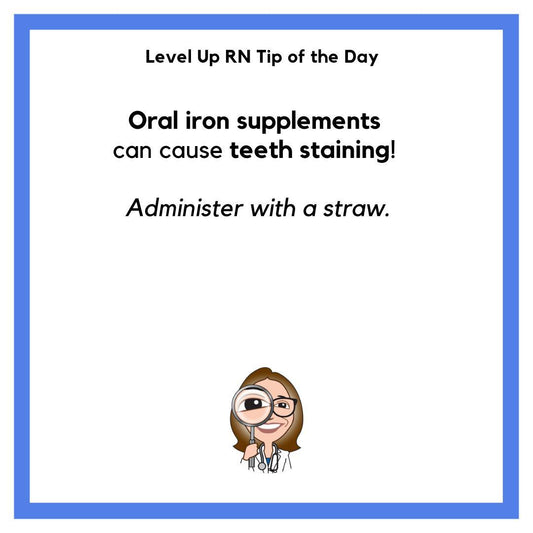
Oral Iron Supplements
Oral iron supplements can cause teeth staining! Administer with a straw.
Oral Iron Supplements
Oral iron supplements can cause teeth staining! Administer with a straw.
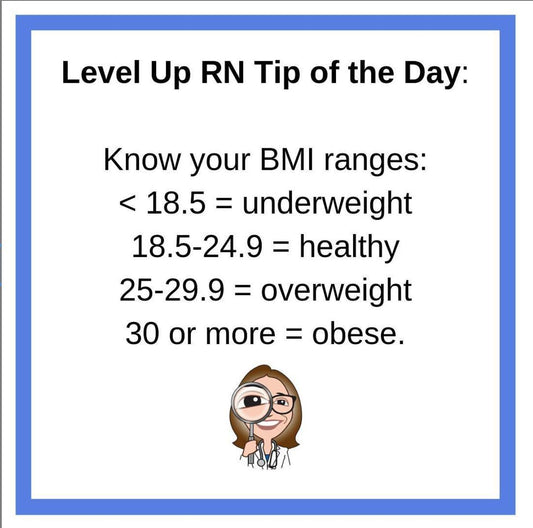
BMI ranges to learn
Know your BMI ranges: <18.5 = underweight, 18.5-24.9 = healthy, 25-29.9 = overweight, 30 or more = obese.
BMI ranges to learn
Know your BMI ranges: <18.5 = underweight, 18.5-24.9 = healthy, 25-29.9 = overweight, 30 or more = obese.
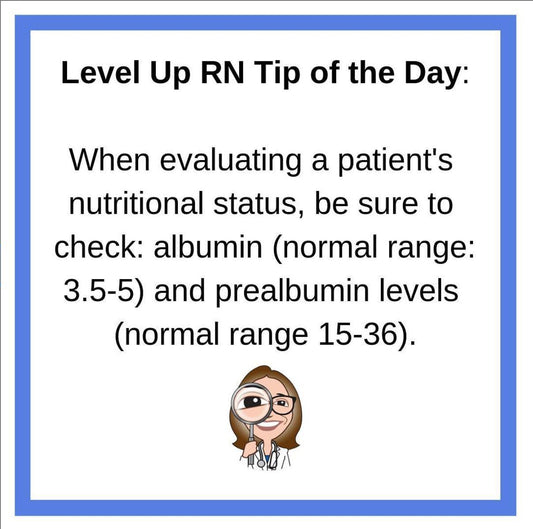
Albumin and prealbumin
When evaluating a patient's nutritional status, be sure to check: albumin (normal range: 3.5-5) and prealbumin levels (normal range 15-36).
Albumin and prealbumin
When evaluating a patient's nutritional status, be sure to check: albumin (normal range: 3.5-5) and prealbumin levels (normal range 15-36).
Filter Articles
Shop
The Ultimate Nursing School Survival Kit - with Flashables and Membership
4.875 / 5.0
(240) 240 total reviews
Regular price $349.95Regular priceUnit price / per$817.95Sale price $349.95SaleVideos by Subject
Tips & More
Exam Information
Subscribe



